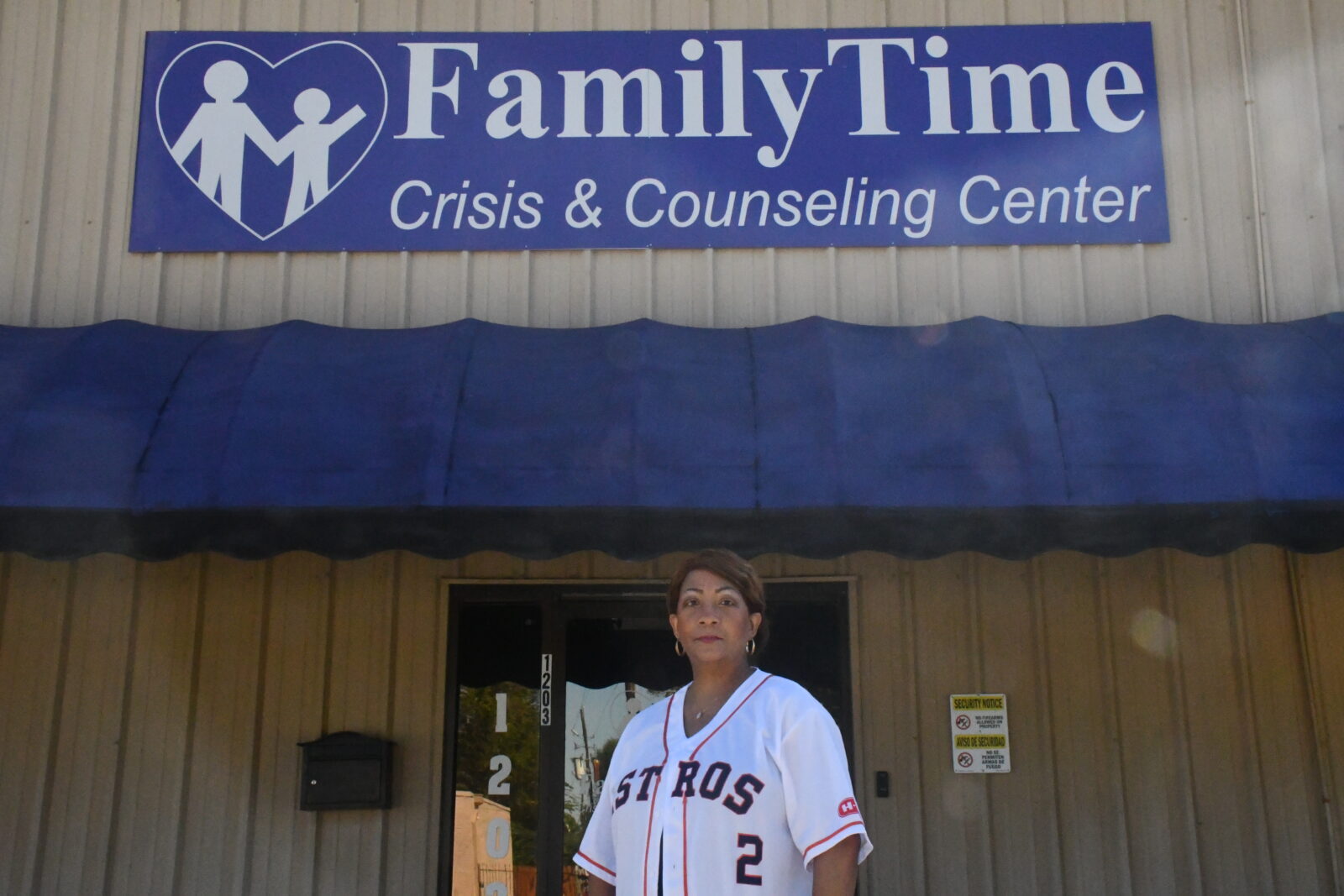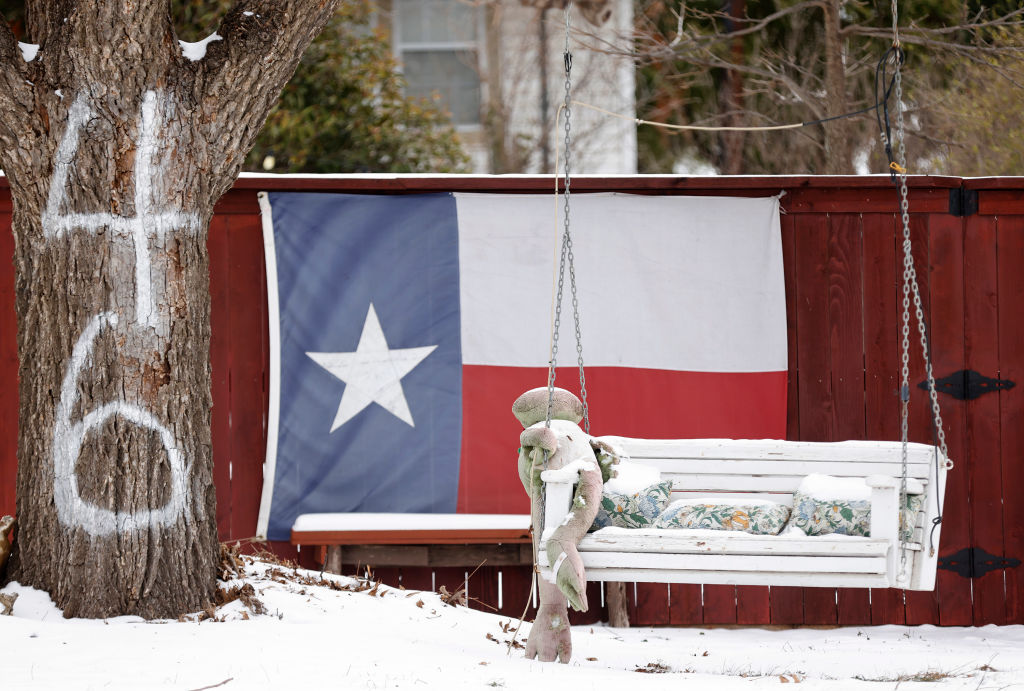HOUSTON – When a deadly winter storm struck in February 2021, tens of thousands of Texans were stuck inside with no power and, often, no water. Michelle J. Abdelnoor was trapped with her abusive boyfriend.
She tried to leave on the first day of the five-day storm, when he blamed her for the time he spent in jail after he was convicted of assaulting her in 2020. But he convinced her to stay, arguing the snow-and-ice storm was even worse at her parents’ home north of Houston than in his downtown house.
He quickly became abusive, she said, pushing her, lightly slapping her face, holding her down and pulling her hair. He tried to disguise his threats as jokes.
“I could see in his face and eyes that he just wanted to hurt me physically, but he would stop himself,” the 39-year-old Abdelnoor said in an interview. She suggested he was trying to avoid doing anything that would leave physical evidence on her body. “It was almost worse mentally, because I didn’t know at what point he was going to explode.”
When she tried to escape, he blocked her path, she said. The storm intensified her sense of danger. “The level of toxicity and abuse was condensed,’’ Abdelnoor said. “The accusations or outbursts of anger that would have taken three weeks were condensed to five days.’’
The winter storm, called “Uri,’’ killed 246 Texans.

While Abdelnoor survived, her experience illustrates the heightened risk of intimate partner violence prompted or exacerbated by natural disasters. Research shows that in the United States, such violence starts or worsens during and after natural disasters, like the one that befell Texas three years ago.
“Often, abusers will point to the environment and the circumstances and say, ‘Well, that’s what made me snap. We’re stuck at home. We’re cold. We have no power. We can’t eat,’” said Christina Allen at FamilyTime Crisis and Counseling Center in Humble, Texas.
The National Academies of Sciences, Engineering, and Medicine reported in January that natural disasters “worsen the frequency and severity of (intimate partner violence)’’ and make access to care and support “even more critical.’’
Storms, floods, wildfires and other natural disasters make it difficult for victims to access help, leaving them even more vulnerable to abuse.
Meanwhile, disasters like these are becoming more frequent and extreme as climate change worsens. A study published in the journal Atmospheric Environment projects that wildfires alone will grow by up to 170% in the western part of the country during the next three decades. Floods, hurricanes and other storms also are projected to increase 25% to 50% during that period.
The latest National Climate Assessment, published in November, found the U.S. experienced 18 weather-related disasters that did more than $1 billion in damages in 2022. Nevertheless, the National Academies report said “scant evidence exists” that federal disaster response teams or volunteer organizations are prepared to respond to intimate partner violence during emergencies.
A complete understanding of the impact of natural disasters on intimate partner violence isn’t possible in the U.S. because there is no comprehensive national database or even standardized emergency call data detailed enough to quantify it. Only a fraction of police departments publish their 911 call data online.
Surveys and studies are hard to compare because researchers often use varying terms and questions when asking about intimate partner violence, the National Academies report found.
The same is true for police departments, which sometimes record intimate partner violence under the umbrella of family violence.
Sue Curry, who chaired the National Academies committee that authored the report, said the lack of awareness and training put women, who are most often the victims of intimate partner violence, at greater risk.
Following Hurricane Katrina in 2005, Mississippi women who were either married or living with their partners were nearly twice as likely to report severe physical abuse than during the six months before the hurricane, according to a study for the journal Violence and Victims. After the hurricane, 8.3% of women reported abuse compared to 4.2% beforehand. Men reported no increase in physical violence, but both men and women said they were more likely to experience psychological abuse by a partner after the storm.
A separate survey of people forced to relocate to Federal Emergency Management Agency trailer parks in Louisiana and Mississippi after Hurricane Katrina found that, 274 days after they were displaced, the rate of intimate partner violence was nearly three times higher than the U.S. baseline rates, the Annals of Emergency Medicine reported.
Researchers studying the effects of Hurricane Harvey in 2017 in Texas found a significant increase in psychological intimate partner violence, climbing to 47% from 36% among study participants, they reported in Social Work Research.
After Uri hit Texas in 2021, a national advocacy organization that provides cash grants to victims of intimate partner violence surveyed those applying for help. The organization, FreeFrom, found that one in four applicants reported that the abuse began or got worse during the storm.
As climate change advances, “women are definitely more at risk,” Jennifer First, lead author of the Hurricane Harvey study, said in an interview.
DISASTERS CAN ISOLATE WOMEN
Sybil Winters-Little at Bay Area Turning Point, a Webster, Texas, provider of services to domestic violence victims, said it can be hard for victims to find a private moment to call a hotline in the midst of a disaster because workplaces and schools close and they often are living with their abusers.
“When it’s all about power and control, if you can isolate your victim from all of their resources, their family, their support system, it’s easier to prey upon them,” said Heather Bellino, CEO of the Texas Advocacy Project, which provides free legal services to survivors of violence. “And there’s less opportunity for them to call for help and get out.”
A Fuller Project analysis of family violence calls to police departments shows they dropped during hurricanes Harvey and Ida and lagged in the aftermath.
Hurricane Harvey caused at least $125 billion worth of damage and killed 88 people in Texas. The hurricane hit Houston on August 26. In just a few days, 20 trillion gallons of water fell on the city. The day after, only 14 calls related to family violence reached the Houston Police Department, the Fuller Project analysis showed. In the three weeks following the hurricane, police received an average of 61 calls per day, significantly less than the 80 average daily calls during the same period in the ensuing five years.

During the nine days of Hurricane Ida, which made landfall in Louisiana in late August of 2021, family violence calls for help to the New Orleans Police Department dropped to their lowest levels of 2021. The police received about 35 calls per day, down from an average of about 44 calls per day during the same period in the previous five years.
Joseph Fernandez, an expert in disaster preparedness and emergency response at Florida International University, explained that those affected by a natural disaster are generally asked not to call emergency services unless they absolutely have to. “We can’t come out. Calls get parked,’’ he said. “Then, as (the storm) lightens up, (911) calls go through the roof.”
Sometimes victims want to seek help but they can’t. Disasters can destroy infrastructure. The New Orleans 911 call center crashed, for instance, when Hurricane Ida hit in 2021, leaving calls for help unanswered. “It is a very common issue,” Fernandez said.
In the five days when the winter storm trapped Texans in their homes and cut off electricity, not a single victim tried to get to the FamilyTime shelter, CEO Christina Allen said. But when the power came back, “hotlines were ringing off the hook” and the call volume remained higher than usual for the following two months, she added.

Chelcee Thomas, executive director of Live Violence Free, said after evacuation orders for the 2021 Caldor Fire in California were lifted, the number of calls to her organization’s crisis line rose. “The fire added another layer of stress,’’ she said. “We heard [from clients] that the abuse was more intense, it was more frequent.”
In Kentucky, staff members noticed that calls for help were more urgent after disasters like a 2021 tornado or historic flash flooding in 2023 in the western part of the state, said Mary Foley, executive director at Merryman House Domestic Crisis Center in Paducah. “We noticed that the types of physical abuse that would threaten their lives with choking, stabbing, guns held to the head — anecdotally, those went up.”
In some cases, the abuse turned deadly.
Aaron Richard Nanni and his wife were estranged and planning to divorce, but were forced back into the same house in Conroe, Texas, during the 2021 winter storm.
On Feb. 20, just days after the storm passed, Nanni told his wife that he was leaving the house. When she arrived at the home later that day with Jeremy Entriken, her new partner, Nanni returned. He fatally shot and killed Entriken, then fatally shot himself.
The Texas Council on Family Violence found that intimate partner homicides occurred twice as often in the four weeks after the winter storm compared to the first six weeks of the year. From Jan. 1 to Feb. 12, the organization tallied 13 homicides. In the following four weeks, 26 people were killed.
STORMS DISRUPT PROTECTIONS
Protective orders can help keep victims safe, but data from Houston’s Harris County, shows Hurricane Harvey disrupted that system. Only two criminal protective orders, which are initiated by the court, were filed on August 27 while the hurricane raged, down from an average of 43 daily filings over the last six years.

“Harvey knocked out our criminal justice center. It literally knocked out the whole building. There were no courts,” said Amy Smith, senior director of operations and communications at the Harris County Domestic Violence Coordinating Council. That caused a backlog in cases, and defendants out on bond continued to torment their victims, she said.
“Most victims just gave up, failed to cooperate, or requested for the cases to be dismissed, so they could get on with their lives,” Smith said. Some are still waiting for their day in court, six years later, she said.
Courts closed again during Winter Storm Uri in 2021. For five full days, not a single person filed for a civil protective order. “There was a freezing of time,” Bellino said. The storm trapped people in abusive relationships without access to any outside support systems. Even a short disruption of services can have dire consequences. “That can be lethal,” she said.

Michelle Abdelnoor survived five days with her abuser during the winter storm in Texas. Four years later, she is building a new life for herself, with a job in compliance that she likes and two dogs. “I remember telling him at one point: No matter how much you try to break me down, I will always rise in a better situation than you left me.”
This story was produced in collaboration with the Howard Center for Investigative Journalism at the University of Maryland. Woelfl and Morton reported for the Howard Center. Howard fellow Abby Wallace also contributed research for the story.


 Lisa Woelfl
Lisa Woelfl
